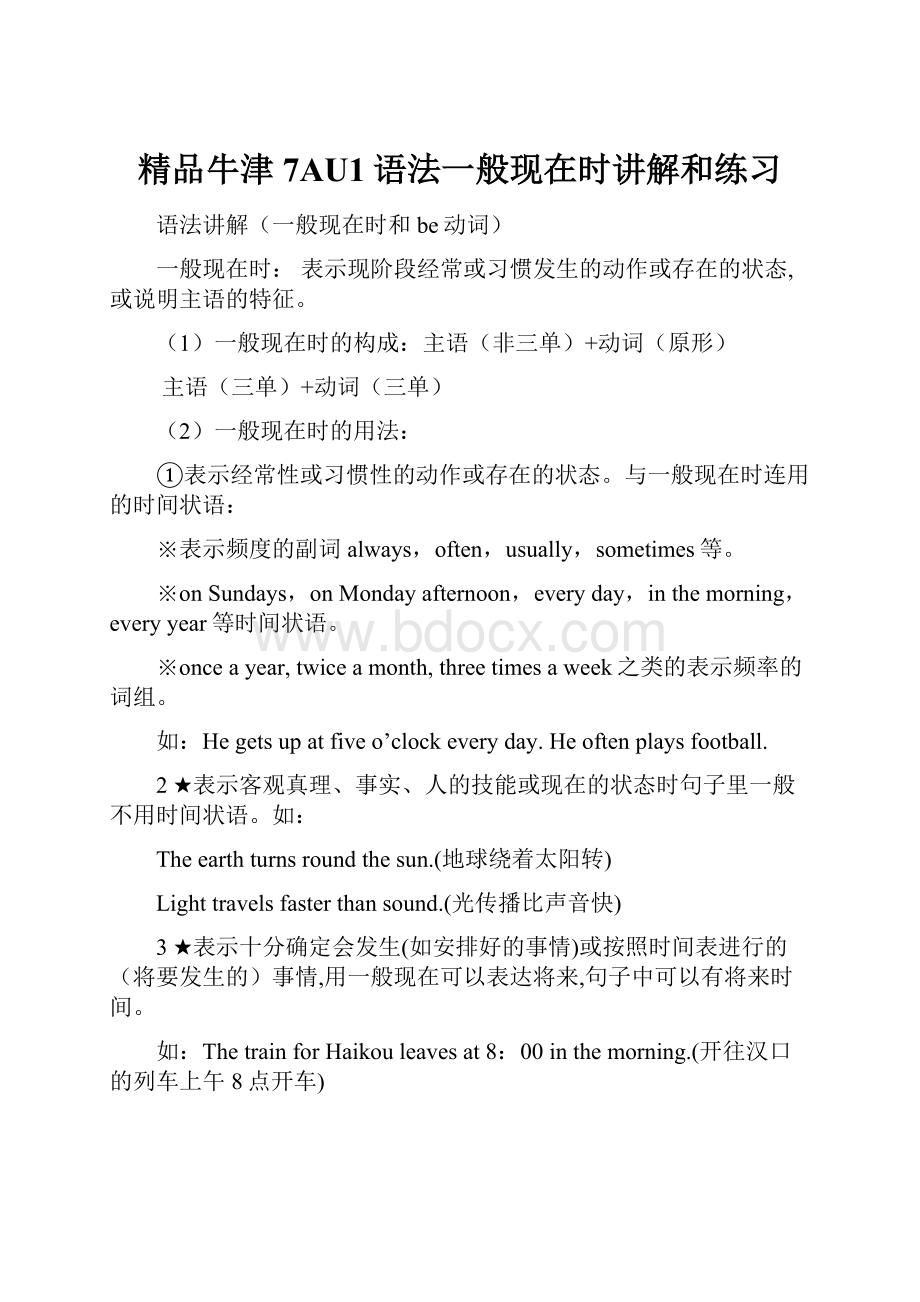 精品牛津7AU1语法一般现在时讲解和练习.docx
精品牛津7AU1语法一般现在时讲解和练习.docx
- 文档编号:9829327
- 上传时间:2023-02-06
- 格式:DOCX
- 页数:12
- 大小:27.33KB
精品牛津7AU1语法一般现在时讲解和练习.docx
《精品牛津7AU1语法一般现在时讲解和练习.docx》由会员分享,可在线阅读,更多相关《精品牛津7AU1语法一般现在时讲解和练习.docx(12页珍藏版)》请在冰豆网上搜索。

精品牛津7AU1语法一般现在时讲解和练习
语法讲解(一般现在时和be动词)
一般现在时:
表示现阶段经常或习惯发生的动作或存在的状态,或说明主语的特征。
(1)一般现在时的构成:
主语(非三单)+动词(原形)
主语(三单)+动词(三单)
(2)一般现在时的用法:
①表示经常性或习惯性的动作或存在的状态。
与一般现在时连用的时间状语:
※表示频度的副词always,often,usually,sometimes等。
※onSundays,onMondayafternoon,everyday,inthemorning,everyyear等时间状语。
※onceayear,twiceamonth,threetimesaweek之类的表示频率的词组。
如:
Hegetsupatfiveo’clockeveryday.Heoftenplaysfootball.
2★表示客观真理、事实、人的技能或现在的状态时句子里一般不用时间状语。
如:
Theearthturnsroundthesun.(地球绕着太阳转)
Lighttravelsfasterthansound.(光传播比声音快)
3★表示十分确定会发生(如安排好的事情)或按照时间表进行的(将要发生的)事情,用一般现在可以表达将来,句子中可以有将来时间。
如:
ThetrainforHaikouleavesat8:
00inthemorning.(开往汉口的列车上午8点开车)
4★在时间状语从句中(以when,after,before,while,until,assoonas等引导)和条件状语从句中(以if,unless引导),用一般现在时代替一般将来时,句子可以有将来时间。
如:
PleaseringmeupassoonasyouarriveinGermany.(你一到德国就给我打电话)/Ifitrainstomorrow,wewillhavetostayathome.(如果明天下雨我们就只好呆在家)
5★一般现在时用于倒装句中可以表示正在发生的动作,动词以come,go为主。
如:
Herecomesthebus.(车来了)/Theregoesthebell.(铃响了)。
一般现在时中be的用法:
2.1be动词的一般现在时
be动词是系动词的一种,表示“……是……”的意思。
现在式(ThePresentForms)有am,is,are三种。
这三种动词的原形是be,所以它们称为be动词。
2.1.1be动词的现在式
be动词的现在式有am,is,are三种,分别接在不同人称的主语之后:
2.1.2be动词句型的构成
肯定句:
主语+be动词(am/is/are)...
否定句:
主语+be动词(am/is/are)+not...
疑问句:
be动词(am/is/are)+主语...?
疑问代词/疑问副词+be动词(am/is/are)+主语...?
2.1.3be动词的肯定句
句型:
主语+be动词...
be动词的肯定句由“主语+be动词(am/is/are)+表语”构成:
Iamadoctor.我是一名医生。
Maryisatwork.玛丽在工作。
Youaremyonlyfriend.你是我惟一的朋友。
2.1.4be动词的否定句
句型:
主语+be动词(am/is/are)+not...
be动词一般现在时的否定句结构,是在be动词am,is,are之后加not:
Wearen'therclassmates.我们不是她的同班同学。
I'mnotTom.我不是汤姆。
(I'm是Iam的缩写,读作/aim/。
)
be动词否定句的缩写方式:
isnot的缩写是isn't,读作/′iznt/;arenot的缩写是aren't,读作/a:
nt/;Iam~的否定句是Iamnot~,缩写为I'mnot~;amnot不缩写在一起。
2.1.5be动词的一般疑问句
句型:
be动词+主语...?
回答方式:
Yes,主语+be动词(am/is/are)...
No,主语+be动词(am/is/are)+not...
be动词的一般疑问句是将be动词置于主语之前(大写am/is/are的第一个字母),在句尾加问号;这种语序是主语和谓语倒装语序:
肯定句:
Theyarefruit.它们是水果。
疑问句:
Aretheyfruit?
它们是水果吗?
(主语和谓语倒装)
肯定句:
Thebookisonthetable.书在桌子上。
(主语和谓语倒装)
疑问句:
Isthebookonthetable?
书是在桌子上吗?
回答由be动词构成的疑问句时,肯定要用Yes,否定用No:
AreyouJohn'sbrother?
—Yes,Iam.你是约翰的兄弟吗?
——是的,我是。
AreMaryandJohnstillatschool?
—No,theyarenot.玛丽和约翰仍在学校吗?
——不,不在了。
Areyouthere?
喂,你听着吗?
(打电话时用)
【注意】Yes或No的后面一定要加逗号,其后的主语小写,I(我)除外。
I永远大写。
在回答句子时,主语必须是代词。
2.1.6be动词的特殊疑问句
句型:
疑问代词(主语)+be动词(am/is/are)...?
疑问代词/疑问副词+be动词(am/is/are)+主语...?
用who和how等疑问代词或疑问副词与be动词构成的疑问句称为特殊疑问句。
就主语提问时,如果主语是疑问代词或是带有疑问限定词的名词词组,如Whatnumberis...?
(什么数字是……?
),Whichboylikes...?
(哪个男孩喜欢……?
),Whosecaris...?
(谁的车是……?
)等,将疑问代词或带有疑问限定词的名词词组置于be动词之前(am,is,are的第一个字母无需大写),在句尾加问号;这种语序是陈述句语序。
就表语提问时,则以一个疑问代词或疑问副词开头,之后是“be动词+主语...”(am,is,are的第一个字母无需大写),在句尾加问号;这种语序是主语和谓语倒装语序。
be动词的特殊疑问句不能用Yes或No来回答:
who“谁”:
Whoisthere?
谁在那里?
(就主语提问)
Whoisshe?
—Sheismymother.她是谁?
——她是我母亲。
(就表语提问)
Whoarethey?
—TheyareJohn’sclassmates.他们是谁?
——他们是约翰的同学。
what(指某一或某种未知的事物或人)“什么”:
Whatarethese?
—Thesearebooks.这些是什么?
——这些是书。
Whatarethey?
—Theyaresailors.他们是干什么的?
——他们是海员。
WhatisSusanlike?
苏珊是什么样的人?
/苏珊的人品如何?
(就介词宾语提问)
whose“谁的”:
Whosehouseisthis?
—ThehouseisJane's.这是谁的房子?
——是简的房子。
Whosearetheseshoes?
—TheyareTom's.这些是谁的鞋子?
——是汤姆的鞋子。
which“哪一个、哪一些”:
Whichofthesebooksisyours?
这些书中哪一本是你的?
Whichisheavier,ironorcopper?
铁和铜,哪一个更重?
where“在哪里”:
Whereishe?
—He'supstairs/athome/intheoffice.他在哪里?
——他在楼上/在家里/在办公室。
WhereareJohnandTom?
—Theyareatschool.约翰和汤姆在哪里?
——他们在学校。
how“怎样、如何”:
HowisHelen?
—Sheisverywell,thankyou.海伦好吗?
——她很好,谢谢您。
Howoldisyoursonnow?
—Heisfifteen.你儿子多大年纪了?
——他15岁了。
Howistheweathertoday?
—Theweatherisnicetoday.今天天气怎样?
——今天天气很好。
2.1.7Thereis/are的用法
Thereis/are用于表示某物或某人的存在。
1.Thereis/are...的肯定句
句型:
Thereis/are+单数/复数名词+表示地点/场所的词或短语:
There'ssomeoneatthedoortoseeyou.门口有个人要见你。
Wherethereisawill,thereisaway.有志者事竟成。
There'sacoolbreezethisevening.今晚有凉爽的微风。
Therearemanyflowersinthegarden.园子里有很多花。
引导词真正的主语地点状语
Therebe结构为倒装句,真正的主语是Thereis/are后的名词,如上述例句。
详见第25章倒装25.1完全倒装。
有的辞典将Therebe结构中的There列为代词,作be的主语
2.Thereis/are的否定句
句型:
Thereis/are+not...
Thereis/are的否定句是在is/are后面加not:
Thereisn'tgoingtobeapartytonight.今晚没有聚会。
Therearen'tanycakesleft.没有一点蛋糕剩下来。
3.Thereis/are的疑问句
一般疑问句句型:
Is/Arethere...?
Thereis/are的一般疑问句是将is/are调到there前面,大写is/are的第一个字母:
Isthereanythingyouwanttotellme?
你有什么事情想告诉我吗?
Arethereenoughtoolstogoround?
工具够大家用吗?
特殊疑问句句型:
疑问副词+形容词+名词+is/are+there...?
Thereis/are~的特殊疑问句是以“疑问副词+形容词+名词等”开头,之后是“is/are+there?
”:
Howmucharethere?
有多少?
Howmanyroomsarethereineachflat?
每套房子里有多少个房间?
Howmanystudentsarethereinyourclass?
你班上有多少名学生?
【注意】Therebe结构中的谓语有时不用动词be,而用seem,appear等:
Thereappearedtobenoonewhocouldanswerourinquiries.似乎没有人能回答我们的询问。
Thereappearstohavebeenanastyaccident.似乎发生了一起严重事故。
Thereseems(tobe)nodoubtaboutit.此事似乎无可置疑。
Theredon'tseemtobeanymissing.好像没有什么丢失了。
2.1.8Here的句型
句型:
Hereis/are+名词.
用于把某物给某人。
主语为名词时,动词放在名词之前;主语为代词时,动词放在代词之后:
Herearetwoboys.这里有两个男孩。
(名词之前)
Hereisthebookyouwant.你要的书在这里。
HereisthepoundIoweyou.这是我欠你的英镑。
Herethey/weare!
他们/我们终于到了!
(代词之后)
但是:
Hereyouare(itis).(=Hereiswhatyouaskedfor.)你所要的东西在这里。
/你找的东西在这里。
此句型还可用于引起对某物或某人注意:
Herecomesthemanager.经理来了。
Herehecomes.他来了。
练习:
1.Theplane______overthere.
A.isB.areC.amD.was
1.I________(be)fromAustralia.2.She_______(be)astudent.
3.JaneandTom_________(be)myfriends.
4.Myparents_______(be)verybusyeveryday.
5._______(be)thereaChineseschoolinNewYork?
6._______(Be)theyexcitedwhenheheardthenews?
7.There_____(be)someglassesonit.
8.Thetwins (be)veryhappy.
9.Ourclass (be)big,buttheirclasses (be)small.
10.Thebasketballclub (be)excitingandfun.
11.Thegirlinredclothes (be)mysister.
12.Lily’sroom (be)notverybig.
13.I____(be)nicetomeetyou.
14.Yourname_____(be)nice.
15. (be)youLiFen?
No,I (be)not.
16. Mr.greenverybusy?
Yes,he (be).
17. (be)theapplesveryfresh?
18.YouandI (be)goodfriends.
19.Hisfriends (be)veryfunny.
20.There______(be)abigplaygroundinourschool.
二.仿照例句改写下列句子。
例句:
SheisinClassOne,GradeTwo.
否定句:
SheisnotinClassOne,GradeTwo.
一般疑问句:
IssheinClassOne,GradeTwo?
回答:
Yes,sheis.(No,sheisn’t)
1.Bobisonthefootballteam.
否定句:
一般疑问句:
回答:
2.Theyareintheteacher’soffice.
否定句:
一般疑问句:
回答:
二、用am,is,are填空
1) I _____ a student.2)You ____ a doctor.3)____she from Jinan?
4)_____you American?
5)He _____ in Class 4, Grade 1.6)It_____ a car.
7)They ____ cars8)____ your mother in China?
16). I ______ a boy. ______ you a boy?
No, I _____ not.
17). The girl______ Jack’s sister. 18). The dog _______ tall and fat.
19). The man with big eyes _______ a teacher.
20). ______ your brother in the classroom?
21). Where _____ your mother?
She ______ at home.
22). How _______ your father?
23). Mike and Liu Tao ______ at school.
24). Whose dress ______ this?
25). Whose socks ______ they?
26). That ______ my red skirt. 27). Who ______ I?
28).The jeans ______ on the desk. 29).Here ______ a scarf for you.
30). Here ______ some sweaters for you.
31). The black gloves ______ for Su Yang.
32). This pair of gloves ______ for Yang Ling.
一、用be的适当形式填空
1.---How____you?
---I____fine.
2.I___David,andmyfamilyname___Green.
3.---Whatcolor___yourclock?
---It___white.
4.---What___thisinEnglish?
---It___anapple.
5.Toy___mybrother.David____mybrother,too.They___mybrothers.
6.Look!
These____appletrees.
7.We____goodstudentsandyou____goodteacher.
8.Mysisterandmybrother_____students.
9._____theremanyeggsinthekitchen?
10.____yourcardnumber5578?
11.Where_____yourpencils?
12.Thsessweaters______fiftydollars.
13.Howmuch____hisjacket?
14.Mybrother’sbirthday____December11th.
15.When_____Kate’sbirthday?
16、There_____aboyandtwogirlsbesidethegate.
17、Fiveandthree____eight.
二、.将下面的句子变成一般疑问句并作出回答
1.Thatismyfootball.
三、将下面的句子变成否定句
1.Hiscardisonthetable.
第一单元综合练习
()1.Hegoestoschoolbybus,buthewalks______afterschool.
A.tohomeB.homeC.hishomeD.thehome
()2.Shelikes_______.Sheisagood_______.
A.swim,swimmingB.swimming,swimmer
C.swimmer,swimmingD.toswim,swim
()3.Ilikereading.Ioftengoto___________.
A.theclassroomB.theReadingClubC.theteacher’sofficeD.thebus
()4.–Iliketalkingonthephonewithmyfriends.--_________.
A.Me,too.B.Youareright.C.Yes,IdoD.Ienjoy.
()5.Excuseme,_____doyousaythatinEnglish?
A.HowB.WhoC.WhereD.What
()6.--Doyouhaveapencil?
--_________.
A.Yes,Ican.B.Yes,Ido.C.No,Iamnot.D.No,Ido.
()7.--CanI_______yournewwatch?
--Sure.
A.lookatB.lookafterC.lookforD.looklike
()8.Jack_______doinghishomeworkateight.
A.finishB.finishsC.finishesD.don’tfinish
()9.--______theboysenjoy_______theWorldCup?
--Yes,they_______.
A.Does,watching,doesB.Do,watch,doC.Do,watching,doD.Does,watch,does
()10.Hesays“_______”tohisparentsbeforehegoestobed.
A.GoodeveningB.GoodbyeC.GoingtobedD.Goodnight
()11.It’stoohot.Youshould______yoursunglasses.
A.breakB.wearC.makeD.clean
()12.What__________Jack__________everySaturday?
A.does,doB.do,doesC.do,doD.does,does
()13.Mycousinisin_________.
A.class4,grade7B.Class4,Grade7C.grade7,class4D.Grade7,Class4
()14.______yourbrothergoodatplayingfootball?
A.AreB.Is
- 配套讲稿:
如PPT文件的首页显示word图标,表示该PPT已包含配套word讲稿。双击word图标可打开word文档。
- 特殊限制:
部分文档作品中含有的国旗、国徽等图片,仅作为作品整体效果示例展示,禁止商用。设计者仅对作品中独创性部分享有著作权。
- 关 键 词:
- 精品 牛津 AU1 语法 一般现在时 讲解 练习
 冰豆网所有资源均是用户自行上传分享,仅供网友学习交流,未经上传用户书面授权,请勿作他用。
冰豆网所有资源均是用户自行上传分享,仅供网友学习交流,未经上传用户书面授权,请勿作他用。


 1212中级汽车维修工考试试题三.docx
1212中级汽车维修工考试试题三.docx
